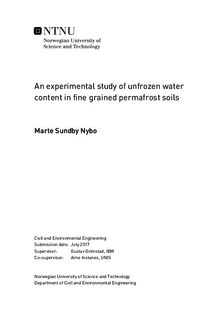An experimental study of unfrozen water content in fine grained permafrost soils
Master thesis
Permanent lenke
http://hdl.handle.net/11250/2457827Utgivelsesdato
2017Metadata
Vis full innførselSamlinger
Sammendrag
The strength of a soil increases when the ground freezes, but some of the water will remain unfrozen. Unfrozen water content is an important thermal property of a soil as flowing water may supply heat, reduce the strength, and thawing ground will experience reduced soil strength and increased settlements. Thus, estimating the unfrozen water content is important for geotechnical design considerations in permafrost areas. Additionally, hydraulic and thermal responses of climate changes can be simulated.
Reliable methods for determining unfrozen water content in frozen soil exist, but requires sophisticated instruments and is time consuming. For engineering purposes, more simple and efficient methods are desired. In this thesis, more recently developed methods for determining unfrozen water content in fine grained soils have been examined, liquid limit determination and water potential testing in particular.
Soil samples from Longyearbyen and Trondheim have been examined and tested in the laboratories of UNIS and NTNU, using liquid limit determination and water potential testing. The test methods have been evaluated and compared against each other. New parameters adapted to Norwegian clays are proposed for the liquid limit determination.
A geothermal Plaxis model for finding thermal properties of fine grained soils are tested on the soils. The model estimates the frost penetration depth, and the result is compared to results obtained by hand calculations. With improvements, the model has potential to become a useful tool in geotechnical designs in permafrost areas.
